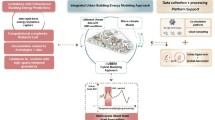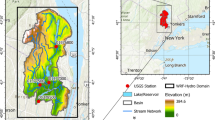Abstract
Parallel back-building convective lines are often observed extending to the southwest of some mesoscale convective systems (MCSs) embedded in the mei-yu front in China. The convective lines with echo training behavior can quickly develop into a stronger convective group of echoes, resulting in locally heavy rainfall within the mei-yu front rainband. The initiation mechanism of the back-building convective lines is still unclear and is studied based on high-resolution numerical simulation of a case that occurred during 27–28 June 2013. In the present case, the new convection along the convective lines was found to be forced by nonuniform interaction between the cold outflow associated with the mei-yu front MCSs and the warm southerly airflow on the south side of the mei-yu front, which both are modified by local terrain. The mei-yu front MCSs evolved from the western to the eastern side of a basin surrounded by several mesoscale mountains and induced cold outflow centered over the eastern part of the basin. The strong southwest airflow ahead of the mei-yu front passed the Nanling Mountains and impacted the cold outflow within the basin. The nonuniform interaction led to the first stage of parallel convective line formation, in which the low mountains along the boundary of the two airflows enhanced the heterogeneity of their interaction. Subsequently, the convective group quickly developed from the first stage convective lines resulted in apparent precipitation cooling that enhanced the cold outflow and made the cold outflow a sharp southward windshift. The enhanced cold outflow pushed the warm southerly airflow southward and impacted the mountains on the southeast side of the basin, where the roughly parallel mountain valleys or gaps play a controlling role in a second stage formation of parallel convective lines.
摘 要
梅雨锋南侧经常观测到有平行的后建对流线形成, 这些对流线可以迅速发展为新的较强的对流系统, 造成梅雨锋内灾害性局地暴雨. 这些对流线的后建机制目前尚不清楚, 本文对2013年6月27–28日一次平行后建对流线过程进行了高分辨率数值模拟研究. 研究发现, 此个例中对流线上的新对流元是由梅雨锋MCSs降水形成的冷池与梅雨锋南侧偏南暖气流之间的不均匀相互作用所触发的, 两者都受到局部地形的影响. MCSs沿梅雨锋由西向东演变, 经过多个中尺度地形围绕的江西盆地, 并在盆地东部形成冷池中心. 梅雨锋前的西南暖气流穿过南岭山脉, 与盆地内的冷池出流相遇, 其非均匀相互作用导致了第一阶段平行后建对流线的形成, 在这一阶段, 沿冷暖气流边界的低矮地形增强了它们相互作用的非均匀性. 随后, 第一阶段的对流线快速发展并组织为新的对流系统, 导致明显的降水降温, 加强了冷池, 并使冷池中心南移. 增强的冷池气流推动西南暖气流南移, 当经过盆地东南侧的山脉时, 在近似平行的山谷或山脉缺口的强迫作用下, 形成了第二阶段平行后建对流线.
Similar content being viewed by others
References
Bluestein, H. B., and M. H. Jain, 1985: Formation of mesoscale lines of precipitation: Severe squall lines in Oklahoma during the Spring. J. Atmos. Sci., 42(16), 1711–1732, https://doi.org/10.1175/1520-0469(1985)042<1711:FOMLOP>2.0.CO;2.
Bluestein, H. B., G. T. Marx, and M. H. Jain, 1987: Formation of mesoscale lines of precipitation: Nonsevere squall lines in Oklahoma during the Spring. Mon. Wea. Rev., 115(11), 2719–2727, https://doi.org/10.1175/1500-0493(1987)115<2719:FOMLOP>2.0.CO;2.
Buzzi, A., N. Tartaglione, and P. Malguzzi, 1998: Numerical simulations of the 1990 Piedmont flood: Role of orography and moist processes. Mon. Wea. Rev., 126(9), 2369–2383, https://doi.org/10.1175/1520-0093(1998)126<2369:NSOTPF>2.0.CO;2.
Chen, S.-J., Y.-H. Kuo, W. Wang, Z.-Y. Tao, and B. Cui, 1998: A modeling case study of heavy rainstorms along the mei-yu front. Mon. Wea. Rev., 126(9), 2330–2351, https://doi.org/10.1175/1520-0093(1998)126<2330:AMCSOH>2.0.CO;2.
Ding, Y. H, 1992: Summer monsoon rainfalls in China. J. Meteor. Soc. Japan, 70, 373–396, https://doi.org/10.2151/JMSJ1965.70.1B_373.
Ding, Z. Y., L. Qian, X. J. Zhao, and F. Xia, 2018: Analysis of three echo-trainings of a rainstorm in the South China warm region. Frontiers of Earth Science, 12(2), 381–396, https://doi.org/10.1007/s11707-017-0651-2.
Ducrocq, V., O. Nuissier, D. Ricard, C. Lebeaupin, and T. Thouvenin, 2008: A numerical study of three catastrophic precipitating events over southern France. II: Mesoscale triggering and stationarity factors. Quart. J. Roy. Meteor. Soc., 134(630), 131–105, https://doi.org/10.1002/qj.199.
Ducrocq, V., and Coauthors, 2013: HyMeX-SOP1: The field campaign dedicated to heavy precipitation and flash flooding in the northwestern Mediterranean. Bull. Amer. Meteor. Soc., 95(7), 1083–1100, https://doi.org/10.1175/BAMS-D-12-00244.1.
Duffourg, F., and Coauthors, 2016: Offshore deep convection initiation and maintenance during the HyMeX IOP 16a heavy precipitation event. Quart. J. Roy. Meteor. Soc., 142(S1), 259–270, https://doi.org/10.1002/qj.2725.
Gao, J. D., M. Xue, K. Brewster, and K. K. Droegemeier, 2004: A three-dimensional variational data analysis method with recursive filter for Doppler radars. J. Atmos. Ocean. Technol., 21(3), 457–469, https://doi.org/10.1175/1520-0426(2004)021<0457:ATVDAM>2.0.CO;2.
Huang, Y. J., Y. B. Liu, Y. W. Liu, H. Y. Li, and J. C. Knievel, 2019: Mechanisms for a record-breaking rainfall in the coastal metropolitan city of Guangzhou, China: Observation analysis and nested very large eddy simulation with the WRF model. J. Geophys. Res., 124(3), 1370–1391, https://doi.org/10.1029/2018JD029668.
Lee, K.-O., C. Flamant, F. Duffourg, V. Ducrocq, and J.-P. Chaboureau, 2018: Impact of upstream moisture structure on a back-building convective precipitation system in south-eastern France during HyMeX IOP13. Atmospheric Chemistry and Physics, 18(23), 16 805–16 862, https://doi.org/10.5194/acp-18-16845-2018.
Liu, X., Y. L. Luo, Z. Y. Guan, and D.-L. Zhang, 2018: An extreme rainfall event in coastal South China during SCM-REX-2010: Formation and roles of rainband and echo trainings. J. Geophys. Res., 123(17), 9256–9278, https://doi.org/10.1029/2018JD028418.
Luo, Y. L., Y. Gong, and D.-L. Zhang, 2013: Initiation and organizational modes of an extreme-rain-producing mesoscale convective system along a Mei-Yu front in East China. Mon. Wea. Rev., 142(1), 203–221, https://doi.org/10.1175/MWR-D-13-00111.1.
Luo, Y. L., Y. J. Wang, H. Y. Wang, Y. J. Zheng, and H. Morrison, 2010: Modeling convective-stratiform precipitation processes on a Mei-Yu front with the Weather Research and Forecasting model: Comparison with observations and sensitivity to cloud microphysics parameterizations. J. Geophys. Res., 115, D18117, https://doi.org/10.1029/2010JD013873.
National Centers for Environmental Prediction, 2003: Historical Unidata Internet Data Distribution (IDD) gridded model data. Research Data Archive at the National Center for Atmospheric Research, Computational and Information Systems Laboratory, Boulder, CO. Available online from doi: https://doi.org/10.5065/509X-KE89.
Rotunno, R., and R. Ferretti, 2001: Mechanisms of intense Alpine rainfall. J. Atmos. Sci., 58(13), 1732–1709, https://doi.org/10.1175/1520-0069(2001)058<1732:MOIAR>2.0.CO;2.
Schumacher, R. S., and R. H. Johnson, 2005: Organization and environmental properties of extreme-rain-producing mesoscale convective systems. Mon. Wea. Rev., 133(4), 961–976, https://doi.org/10.1175/MWR2899.1.
Sun, S. Q., J. Zhen, S. L. Zhi, A. H. Xu, Y. H. Chen, Z. J. Shen, and A. B. Yu, 2015: Analysis of a Meiyu-Front rainstorm caused by “Train Effect”. Plateau Meteorology, 34(1), 190–201, https://doi.org/10.7522/j.issn.1000-0534.2013.00146. (in Chinese with English abstract)
Tsuguti, H., N. Seino, H. Kawase, Y. Imada, T. Nakaegawa, and I. Takayabu, 2019: Meteorological overview and mesoscale characteristics of the heavy rain event of July 2018 in Japan. Landslides, 16(2), 363–371, https://doi.org/10.1007/s10346-018-1098-6.
Wang, H., Y. L. Luo, and B. J.-D. Jou, 2010: Initiation, maintenance, and properties of convection in an extreme rainfall event during SCMREX: Observational analysis. J. Geophys. Res., 119(23), 13 206–13 232, https://doi.org/10.1002/2014JD022339.
Wang, Q. W., and Z. M. Tan, 2006: Flow regimes for major topographic obstacles of China. Chinese Journal of Geophysics, 49(4), 971–982, https://doi.org/10.3321/j.issn:0001-5733.2006.04.007. (in Chinese with English abstract)
Wang, Q.-W., and M. Xue, 2012: Convective initiation on 19 June 2002 during IHOP: High-resolution simulations and analysis of the mesoscale structures and convection initiation. J. Geophys. Res., 117(D12), D12107, https://doi.org/10.1029/2012JD017552.
Xue, M., K. K. Droegemeier, and V. Wong, 2000: The Advanced Regional Prediction System (ARPS)—A multi-scale nonhydrostatic atmospheric simulation and prediction model. Part I: Model dynamics and verification. Meteorol. Atmos. Phys., 75(3–4), 161–193, https://doi.org/10.1007/S007030070003.
Xue, M., D. H. Wang, J. D. Gao, K. Brewster, and K. K. Droegemeier, 2003: The Advanced Regional Prediction System (ARPS), storm-scale numerical weather prediction and data assimilation. Meteorol. Atmos. Phys., 82(1–4), 139–170, https://doi.org/10.1007/S00703-001-0595-6.
Xue, M., and Coauthors, 2001: The Advanced Regional Prediction System (ARPS)—A multi-scale nonhydrostatic atmospheric simulation and prediction tool. Part II: Model physics and applications. Meteorol. Atmos. Phys., 76(1), 103–165, https://doi.org/10.1007/S007030170027.
Zhang, J., and Z. M. Tan, 2009: A simulation study of the mesoscale convective systems associated with a Meiyu frontal heavy rain event. J. Meteorol. Res., 23(4), 438–454.
Acknowledgements
This work was primarily supported by the National Key R&D Program of China (Grant No. 2017YFC1501603), the Major Research Plan of the National Natural Science Foundation of China (Grant No. 91937301), and the National Natural Science Foundation of China (Grant Nos. 41775054, 41375061 and 40705019). The NCEP reanalysis data used to reproduce the weather background and to initialize the simulations were downloaded from the NCAR Data Archive. The infrared brightness temperature data used to show the cloud clusters were obtained from the satellite data archive for research and education at https://weather.is.koch-u.ac.jpssat/GAME. The observed precipitation data were obtained from the National Meteorological Information Center of China (available at http://data.cma.cn/data/detail/dataCode/SEVP_CLI_CHN_MERGE_CMP_PRE_HOUR_GRID_0.10/keywords/CMORPH.html). The observed station temperature data were from the observations of the automatic weather stations (AWS). We appreciate help from Dr. Dexian FANG to provide the radar observations of Nanchang, Ji’ an, and Shangrao to verify the simulations. We are grateful to the High-Performance Computing Center (HPCC) of Nanjing University for doing the numerical calculations in this paper on its blade cluster system. We thank the two anonymous reviewers, whose comments improved the manuscript.
Author information
Authors and Affiliations
Corresponding author
Additional information
Article Highlights
• Evolution of the mei-yu front MCSs over a basin induces cold outflow centered over the eastern of the basin.
• The low mountains within the basin modify the cold-warm airflow interaction resulting in the first stage formation of the convective lines.
• The mountains on the southeast side of the basin play a controlling role in the second stage formation of the convective lines.
Rights and permissions
About this article
Cite this article
Wang, Q., Zhang, Y., Zhu, K. et al. A Case Study of the Initiation of Parallel Convective Lines Back-Building from the South Side of a Mei-yu Front over Complex Terrain. Adv. Atmos. Sci. 38, 717–736 (2021). https://doi.org/10.1007/s00376-020-0216-2
Received:
Revised:
Accepted:
Published:
Issue Date:
DOI: https://doi.org/10.1007/s00376-020-0216-2




